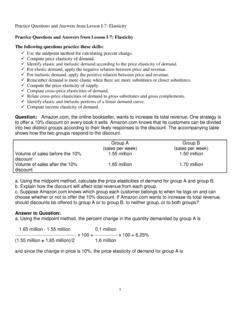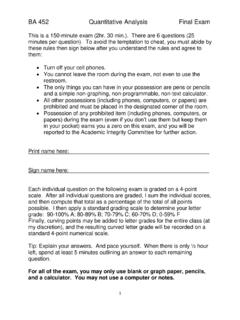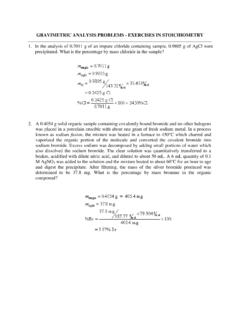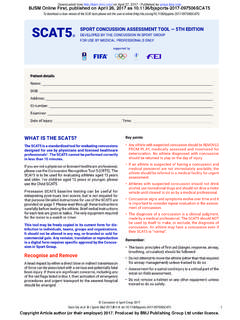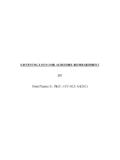Transcription of Determination of the Rate Law for Food Dye Bleaching with ...
1 Determination of the Rate Law for Food Dye Bleaching with Hypochlorite Author 1 Name, Author 2 Name, Author 3 Name General Chemistry II Lab, Wednesday 6-9 Note the title, authors, and affiliation. If this were a manuscript for publication the affiliation would be where the authors work or study. Abstract Normally, the abstract would go here but since the abstracts are handwritten, they can be stapled to the back. Introduction (1) As a courtesy to the grader, identify the author number of this section for this week. Common household liquid bleach is often a solution of sodium or calcium hypochlorite.
2 Being a powerful oxidizing agent, the hypochlorite ion can decompose many organic substances. In this experiment, bleach will used to decompose the FC&C blue dye #1, commonly found in blue-colored beverages and snacks. Double-spacing (or spacing) is better it s easier for a reader. We are exploring the relationship between the time it takes to completely or nearly so bleach the dye and the concentration of the bleach necessary to do so. There are several factors that affect the rate of a reaction, including concentration of reactants, surface area of a reactant in a heterogeneous reaction, temperature, pressure (if a reactant is a gas), and the presence of a catalyst.
3 In this report , we present the chemical conditions necessary to achieve nearly complete decomposition of the dye in about 15 minutes. We also present the rate law for the reaction Dye + ClO- products (1) Notice that the equation is numbered so that it can be referenced in the text if necessary despite not having knowledge of the stoichiometry nor the products of the reaction. The general form of the rate law for the reaction can be written Rate = k[dye]x[ClO-]y (2) Since x and y are not directly related to the stoichiometry of the reaction the correct reaction stoichiometry doesn t need to be known.
4 The values of x and y are the orders of the reaction in the respective reactant and k is the rate constant for the reaction. Reaction progress is monitored spectroscopically using the Spectronic-20 spectrophotometer. The reaction orders can be obtained by the method of initial rates or by linearizing the concentration vs. time plot with the integrated rate law of the appropriate order (zeroeth, first, or second order). The reaction will be forced into pseudo-order conditions by using a huge excess of hypochlorite and a limiting amount of dye.
5 In this way, the [ClO-] will remain essentially unchanged over the course of the reaction and the experimentally-determined rate constant, k This is an example report of an investigation performed in General Chemistry lab. Pay attention to format and content, not on the results or the experiment itself. The report is best explored on screen or printed in color since editor comments are in red. The names have been withheld to protect the authors. This would be considered a very good report and a quality to aspire to in the General Chemistry I lab.
6 (also called the apparent rate constant), will be a composite of the actual rate constant, k, and the [ClO-]: k' = k[ClO-]y (3) In one experiment, the [dye] vs time will be monitored at a fixed and known [ClO-]. The curve will be linearized by plotting ln[dye] vs time and [dye]-1 vs time and selecting the most linear plot to assign the reaction order in dye. The slope of the line is the apparent rate constant, k . By changing the concentration of the hypochlorite and keeping the dye concentration constant, the experiment can be run again.
7 A new k will be measured and from the differences in the former and latter apparent rate constants and the [ClO-], the reaction order in hypochlorite, y, will be determined as well as the actual rate constant, k, for the reaction. Experimental (3) This experimental could be improved by having subheadings since there are 3 distinctly different parts to the experiment. Subheadings are shown in green italics All spectroscopic measurements were performed with a Spectronic-20 spectrophotometer (Bausch & Lomb) set at 630 nm. Cylindrical cuvettes with a nominal pathlength of 1 cm were used for solutions to be analyzed.
8 Deionized water was used for the 100%T reference on the spectrophotometer. The zero and 100%T were checked frequently during the experiment. A stock solution of FD&C Blue #1 with a concentration of 10-6 M (note that would be unacceptable) was prepared in advance and available on the shelf in the laboratory. Undiluted commercial bleach (Chlorox) was provided in the laboratory. The concentration of hypochlorite reported for the bleach was M. Preparation of the Beer s Law Calibration Plot Three 25 mL calibration solutions of FD&C Blue #1 were prepared from dilutions of the stock dye solution.
9 A 10 mL aliquot of the stock dye solution was dispensed from a burette into a 25 mL volumetric flask and diluted to the mark with water to give a 10-6 M solution of dye. A 15 mL aliquot of the stock dye solution was transferred into the second and 20 mL into the third 25 mL volumetric flask and diluted to the mark to give 10-6 M and 10-6 M dye solutions, respectively. The stock dye solution was used undiluted as the fourth calibration solution. The percentage transmittance of each calibration solution was measured once.
10 The percentage transmittances were converted to absorbance with the equation A = -log(%T) (4) The calibration data are summarized in Table 1. A Beer s law calibration plot was prepared by plotting absorbance vs. concentration (Figure 1) yielding a best-fit equation of the line of A = 105M-1c + Notice that Table 1 has a descriptive caption, the exponential data are presented in the customary format and the displayed precision is correct.


